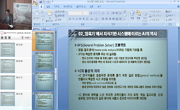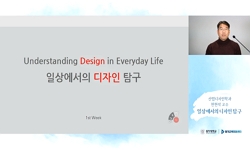This study examined the interactionist approach to creative behavior from the systems theory and dialectical perspective. This approach, which is also referred to ecological approach or systems theory, views creativity as a process shaped by multiple ...
http://chineseinput.net/에서 pinyin(병음)방식으로 중국어를 변환할 수 있습니다.
변환된 중국어를 복사하여 사용하시면 됩니다.
- 中文 을 입력하시려면 zhongwen을 입력하시고 space를누르시면됩니다.
- 北京 을 입력하시려면 beijing을 입력하시고 space를 누르시면 됩니다.

창의적 행동에 대한 상호작용 주의적 접근: 체제적이고 변증법적인 창의의 과정 = The interactionist perspective of creative behavior: An analysis of creativity from the systems theory and dialectical thinking
한글로보기부가정보
다국어 초록 (Multilingual Abstract)
This study examined the interactionist approach to creative behavior from the systems theory and dialectical perspective. This approach, which is also referred to ecological approach or systems theory, views creativity as a process shaped by multiple forces and as an emergent property resulting from the interactions between/ among key subsystems. A system is a group of interdependent, interconnected and interactive elements forming a complex whole. Though the concept of dialectic has evolved over time through history, modern dialectical thinking usually refers to a form of reasoning associated with the logic of dialectic of three-step formula - thesis-antithesis-synthesis. Creative mechanism could be built into the structure of these three-step formula and might be regarded as a form of higher-order thinking, specifically post-formal reasoning. Contradictions or conflicts arising within any system need to be resolved for the system to restore equilibrium. In essence, 'contradiction - resolution' is the major principle through which the three-step formula works, which also applies to the creative behavior. Change implied in the dialectical worldview might be also inherent in creativity as we assume reality is being dynamic as opposed to static. Creativity and innovation processes are basically characterized by many conflicting demands or dialectical paradoxes and this necessitates a dialectical perspective to integrate and balance. Several tactics or strategies have been suggested to cope with paradoxes and to improve creative potentials. Finally this study examined the implications of the conclusions and suggested several recommendations for the further studies.
국문 초록 (Abstract)
창의(력)에 대한 상호작용 주의적 접근을 체제이론과 변증법적인 시각에서 분석해 보았다. 상호작용 주의적 접근은 창의적 행동을 하나의 체제를 이루고 있는 두 개 또는 몇 개의 요소(요인,...
창의(력)에 대한 상호작용 주의적 접근을 체제이론과 변증법적인 시각에서 분석해 보았다. 상호작용 주의적 접근은 창의적 행동을 하나의 체제를 이루고 있는 두 개 또는 몇 개의 요소(요인, 변수)들의 상호작용의 과정으로 보며, 창의란 개인과 환경의 상호작용 속에 존재한다고 말한다. 체제는 순환적인 인과관계가 있는 요소들이 함께 하나의 포괄적인 전체를 구성하며, 전체는 부분들의 총합 이상이고 또한 더 큰 다른 체제의 한 부분이라 본다. 변증법은 체제적이며 삼단논법으로 표현되는 추리의 한 가지 형식 내지 구조를 말하며, ‘정 - 반 - 합’이라는 변증법적 추리의 형식을 취한다. 이러한 변증법적인 추리는 형식적 추리의 단계를 넘어선 ‘후형식적 추리’라는 보다 고차적인 사고의 형태/형식의 것이며 그리하여 구조나 성질상으로 보면 그것은 창의적인 것이다. 체제는 역동적이며 체제 내에서 일어나는 모순과 갈등은 모순-해결의 원리에 따라 통합되면서 평형이 유지되는데 대부분의 창의의 과정은 이러한 원리에 따르는 것으로 분석해 보았다. 그리고 창의적 문제해결의 과정은 체제적이고 변증법적이기 때문에 거기에는 서로 모순되고 대립되는 변증법적인 역설들이 적지 않게 있으며, 창의적 문제해결의 행동에서는 이러한 역설적인 과정들을 자유롭게 이동할 수 있어야 한다. 이에 따라 창의력에 대한 체제적이고 변증법적인 접근이 요구하고 있는 것들을 야누스적 사고와 양손잡이 조직, 역설을 통한 아이디어의 생성 및 창의를 위한 열린 상상과 다중의 경로 등으로 나누어 분석해 보았다. 마지막으로 본 연구의 결과가 가지는 함의와 후속의 연구를 위한 제언 몇 가지도 같이 제시하였다.
참고문헌 (Reference)
1 김영채, "해외 선진국 창의성 전문기관 벤치마킹방안 연구" 서울 산업진흥원 2014
2 김영채, "창의력의 이론과 개발" 교육과학사 2007
3 김영채, "지식의 이중주" 해나무 130-143, 2009
4 전헌선, "중등학교 교사가 지각한 창의적 인성 특성 연구" 대한사고개발학회 4 (4): 19-32, 2008
5 신동형, "이노베이션 3. 0" 알키 2011
6 이미혜, "유아즉흥연주에 나타난 창의적 사고의 이해" 대한사고개발학회 10 (10): 1-20, 2014
7 정미선, "연령에 따른 창의적 사고와 창의적 성격의 발달경향" 대한사고개발학회 6 (6): 69-88, 2010
8 김회용, "상상력과 교육의 관계 연구" 대한사고개발학회 11 (11): 87-109, 2015
9 양용칠, "기초적 사고 기능의 개발을 위한 수업 조건" 대한사고개발학회 9 (9): 23-46, 2013
10 Arlin, P. K., "Wisdom: Its nature, origins, and development" Cambridge University Press 1990
1 김영채, "해외 선진국 창의성 전문기관 벤치마킹방안 연구" 서울 산업진흥원 2014
2 김영채, "창의력의 이론과 개발" 교육과학사 2007
3 김영채, "지식의 이중주" 해나무 130-143, 2009
4 전헌선, "중등학교 교사가 지각한 창의적 인성 특성 연구" 대한사고개발학회 4 (4): 19-32, 2008
5 신동형, "이노베이션 3. 0" 알키 2011
6 이미혜, "유아즉흥연주에 나타난 창의적 사고의 이해" 대한사고개발학회 10 (10): 1-20, 2014
7 정미선, "연령에 따른 창의적 사고와 창의적 성격의 발달경향" 대한사고개발학회 6 (6): 69-88, 2010
8 김회용, "상상력과 교육의 관계 연구" 대한사고개발학회 11 (11): 87-109, 2015
9 양용칠, "기초적 사고 기능의 개발을 위한 수업 조건" 대한사고개발학회 9 (9): 23-46, 2013
10 Arlin, P. K., "Wisdom: Its nature, origins, and development" Cambridge University Press 1990
11 Tushman, M. I., "Winning through innovation: A practical guide to leading organizational change and renewal" Harvard Business School Press 1997
12 Selby, E. C., "VIEW : Technical Manual" Center for Creative Learning 2007
13 David Cropley, "Understanding Value Innovation in Organizations: A Psychological Framework" 대한사고개발학회 21 (21): 17-36, 2011
14 Torrance, E. P., "The search of satori and creativity" Creative Education Foundation 1979
15 Wallas, G., "The psychology of thinking" McGraw-Hill 1926
16 Csikszentmihalyi, M., "The nature of creativity" Cambridge University Press 1988
17 Sternberg, R. J., "The nature of creativity" 18 (18): 87-98, 2006
18 Gordon, W. J., "The metaphorical way of knowing" Porpoise Books 1973
19 Maslow, A. H., "The farther reaches of human nature" Viking 1971
20 Gruber, H., "The evolving systems approach to creative work" 1 : 27-59, 1988
21 Boden, M. A., "The creative mind : Myths and mechanism" Basic Books 1991
22 Koestler, A., "The act of creation" Macmillan 1964
23 Stein, M. I., "Stimulating creativity : Group Procedures(vol. Ⅱ)" Rand McNally 1975
24 Haner, U. E., "Spaces for creativity and innovation in two established organizations" 14 : 288-298, 2005
25 Renzulli, J. S., "Schools for talent development : A practical plan for total school improvement" Creative Learning Press 1994
26 Isaksen, S., "Meeting the innovation challenge" John Wiley & Sons 2006
27 Roherts, B., "Managing invention and innovation" 33 : 1-19, 1988
28 John Baer, "Lectures May Be More Efective Than You Think: The Learning Pyramid Unmasked" 대한사고개발학회 20 (20): 15-28, 2010
29 MacKinnon, D. W., "In search of human effectiveness : Identifying and developing creativity" Bearly 1978
30 Stein, M. I., "Handbook of personality theory and research" Rand McNally 900-942, 1968
31 Amabile, T. M., "Growing up creative : Nurturing a lifetime of creativity" Creative Education Foundation Press 1989
32 Isaksen, S. G., "Frontiers of creativity research : Beyond the basics" Bearly 1984
33 서금택, "FIE 프로그램이 저소득 계층 아동의 지능 및 학업성취에 미치는 효과" 대한사고개발학회 9 (9): 75-94, 2013
34 Bledow, R., "Extending and refining the dialectic perspective on innovation : There is nothing as practical as a good theory : Nothing as theoretical as a good practice" 2 : 363-373, 2009
35 Kaufman, G., "Expanding the mood-creativity equation" 19 : 105-122, 2003
36 Lubart, T. I., "Encyclopedia of creativity, Vol. 1" 295-300, 1999
37 Yan, B., "Encyclopedia of creativity (vol. 1)" Academic Press 547-552, 1999
38 Rosenberg, A., "Encyclopedia of creativity (Vol. 2)" Academic Press 103-108, 1999
39 김광수, "Effect of consistence of a debater's initial position and assigned position on opinion change in an open online debate" 대한사고개발학회 9 (9): 87-101, 2013
40 Csikszentmihalyi. M., "Developing creativity in higher education: An imaginative curriculum" Rotledge 18-20, 2006
41 Sternberg, R. J., "Defying the crowd : Cultivating creativity in a culture of conformity" Free Press 1995
42 Woodman, R. W., "Creativity assessment: Reading and resources" Creative Education Foundation 467-477, 1999
43 Csikszentmihalyi, M., "Creativity : Flow and the psychology of discovery and invention" Harper Collins 1996
44 Cropley, A. J., "Creativity : A bundle of paradoxes" 12 : 8-14, 1997
45 Guilford, J. P., "Creativity" 5 : 444-454, 1950
46 Treffinger, D. J., "Creative productivity : Understanding its sources and nature" 10 : 6-8, 1991
47 Besemer, S. P., "Creating products in the age of design" New Forums Press 2006
48 Arlin, F. K., "Cognitive development in adulthood : A fifth stage?" 11 : 602-606, 1975
49 유연옥, "CoRT 사고활동이 유아의 사회적 기술과 창의성에 미치는 영향" 대한사고개발학회 11 (11): 1-17, 2015
50 Snow, R. E., "Aptitude theory : Yesterday, today, and tomorrow" 27 (27): 5-32, 1992
51 Woodman, A. W., "An interactionist model of creative behavior" 24 (24): 279-290, 1990
52 Isaksen, S. G., "An ecological approach to creative research : Profiling for creative problem solving" 27 (27): 149-170, 1993
53 Rhodes, M., "An analysis of creativity" 42 : 305-310, 1961
54 Michael F. Shaughnessy, "An Interview with Shelley Carson: Creativity and It’s Relatives" 대한사고개발학회 24 (24): 29-35, 2014
55 Kirton, M. J., "Adaptors and innovators : A description and measure" 61 : 622-629, 1989
56 홍기칠, "AbPS 창의력 프로그램을 적용한 수업이 초등학생의 창의적 문제해결력과 창의적 성향에 미치는 효과" 대한사고개발학회 8 (8): 51-76, 2012
57 Helson, R., "A longitudinal study of creative personality in woman" 12 : 89-102, 1999
58 Bledow, R., "A dialectic perspective on innovation : Conflicting demands, multiple pathways, and ambidexterity" 2 : 305-337, 2009
동일학술지(권/호) 다른 논문
-
- 대한사고개발학회
- 유헌식
- 2015
- KCI등재
-
- 대한사고개발학회
- 양용칠
- 2015
- KCI등재
-
- 대한사고개발학회
- 김은영
- 2015
- KCI등재
-
예비중등교사를 위한 창의·인성 교육프로그램의 효과 분석
- 대한사고개발학회
- 이경희
- 2015
- KCI등재
분석정보
인용정보 인용지수 설명보기
학술지 이력
| 연월일 | 이력구분 | 이력상세 | 등재구분 |
|---|---|---|---|
| 2027 | 평가예정 | 재인증평가 신청대상 (재인증) | |
| 2021-01-01 | 평가 | 등재학술지 유지 (재인증) |  |
| 2018-01-01 | 평가 | 등재학술지 유지 (등재유지) |  |
| 2015-01-01 | 평가 | 등재학술지 선정 (계속평가) |  |
| 2013-01-01 | 평가 | 등재후보학술지 유지 (기타) |  |
| 2012-01-01 | 평가 | 등재후보학술지 유지 (기타) |  |
| 2011-01-01 | 평가 | 등재후보학술지 유지 (등재후보1차) |  |
| 2009-01-01 | 평가 | 등재후보학술지 선정 (신규평가) |  |
학술지 인용정보
| 기준연도 | WOS-KCI 통합IF(2년) | KCIF(2년) | KCIF(3년) |
|---|---|---|---|
| 2016 | 1.34 | 1.34 | 1.6 |
| KCIF(4년) | KCIF(5년) | 중심성지수(3년) | 즉시성지수 |
| 1.57 | 1.48 | 2.197 | 0.46 |




 KCI
KCI







